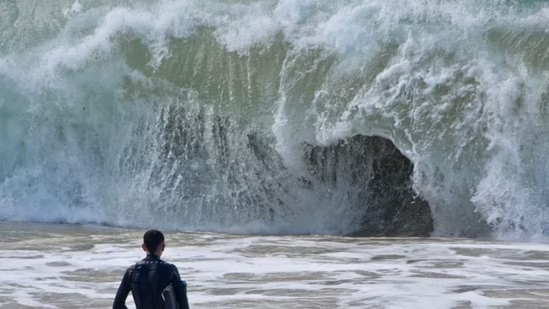What is mega tsunami? Is US at risk? Here’s all you need to know

Northern Oregon, southern Washington, and northern California identified as the U.S. regions most at risk from a Cascadia mega-tsunami.
The term mega tsunami often sparks images of towering walls of water swallowing coastlines in minutes. While ordinary tsunamis are already devastating, mega tsunamis represent an even greater, though far rarer, hazard. With recent conversations about natural disaster threats in the U.S., it’s important to understand what mega tsunamis are, how they form, where the risks lie, and why preparedness still matters despite their rarity.
What Is a Mega Tsunami?
A mega tsunami is not just a bigger version of a normal tsunami. While typical tsunamis form from undersea earthquakes, mega tsunamis are usually triggered by massive, sudden displacements of water. These can occur when enormous landslides, volcanic collapses, or asteroid impacts plunge into an ocean or lake, pushing out waves far larger than those caused by tectonic shifts.
Unlike traditional tsunamis, which may reach 30–100 feet in height when they strike the coast, mega tsunamis can create waves of hundreds or even thousands of feet, depending on the trigger and location.
Historical Examples of Mega Tsunamis
The most famous recorded example is the 1958 Lituya Bay tsunami in Alaska. When a huge landslide crashed into the narrow fjord, it generated a wave that reached an astonishing 1,720 feet—the tallest wave ever documented on Earth. Although the bay was sparsely populated, the sheer scale of the event demonstrates what is possible under the right conditions.
Scientists also point to prehistoric events, such as a collapse in the Canary Islands around 70,000 years ago, which some studies suggest may have generated giant waves across the Atlantic. While evidence is debated, the scenario shows that landslides on volcanic islands could theoretically produce transoceanic mega tsunamis.
Could a Mega Tsunami Threaten the U.S.?
While the likelihood is extremely low, there are scenarios that concern scientists:
-
Canary Islands Volcanic Collapse
One widely discussed possibility involves the Cumbre Vieja volcano in the Canary Islands. Some geologists warn that if a massive flank of the volcano were to collapse into the Atlantic, it could displace enough water to generate waves traveling thousands of miles. Simulations suggest the U.S. East Coast could face waves tens of feet high—enough to inundate coastal cities. However, many scientists argue that such a collapse is unlikely to happen suddenly, and that models may exaggerate the potential impact.
-
Alaska and Pacific Landslides
Alaska’s steep mountains and fjords are hotspots for landslide-generated tsunamis, like the 1958 Lituya Bay event. In 2020, geologists warned that warming temperatures and melting glaciers are destabilizing slopes in Prince William Sound, raising concerns about future massive landslides and locally destructive tsunamis. While these would primarily impact Alaska, the waves could disrupt maritime routes and coastal communities. -
Asteroid or Meteor Impacts
Though rare, an asteroid striking the ocean could generate a true mega tsunami. Unlike earthquakes or volcanic collapses, these events could displace colossal volumes of water in seconds, leading to waves hundreds of feet tall crossing oceans. NASA and international space agencies now monitor near-Earth objects precisely because of this risk, however unlikely it may be.
Mega Tsunami vs. “Ordinary” Tsunami
The U.S. has more direct exposure to “ordinary” tsunamis, which themselves are devastating. For example, the 2011 Tōhoku earthquake and tsunami in Japan produced waves over 130 feet high in some places and sent smaller but still significant waves across the Pacific, reaching California and Oregon. The U.S. West Coast has long prepared for tsunamis from major subduction-zone earthquakes, particularly from the Cascadia Subduction Zone, which could unleash waves 20–80 feet high.
By contrast, mega tsunamis remain largely theoretical on a global scale. Their potential is real, but the likelihood of one striking the U.S. is far less than the risk from conventional tsunamis.
Why Awareness Still Matters
Even if mega tsunamis are rare, studying them helps strengthen disaster preparedness. Rising sea levels, denser coastal populations, and more sophisticated modeling all make understanding extreme hazards vital. For U.S. residents, the lessons include:
-
Preparedness Saves Lives: Even “smaller” tsunamis can be deadly. Coastal evacuation plans, early warning systems, and community awareness remain the first line of defense.
-
Monitoring Risks: Agencies like NOAA’s Pacific Tsunami Warning Center and USGS monitor seismic activity, volcanoes, and landslides to provide alerts.
-
Learning from History: Events like the 1958 Lituya Bay mega tsunami show that nature can surprise us with sudden, extreme scenarios—even in remote places.
A mega tsunami striking the U.S. remains a highly unlikely but scientifically possible event. The East Coast is occasionally cited in worst-case scenarios linked to volcanic collapse in the Canary Islands, while Alaska’s fjords present more localized but realistic risks. For most Americans, the greater concern is traditional tsunamis generated by earthquakes, especially in the Pacific.
Understanding the difference between a tsunami and a mega tsunami is not about creating fear—it’s about appreciating the scale of natural forces and ensuring coastal communities are prepared for all possibilities.


